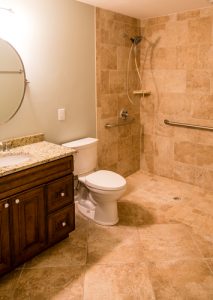 Tips for a Wheelchair Accessible Shower
Tips for a Wheelchair Accessible Shower
For individuals with mobility issues, simple daily tasks can be challenging, and taking a shower can be one of them. Fortunately, there are ways to make your bathroom more accessible, so you can enjoy a safe and comfortable shower.
Here are some tips for creating a wheelchair accessible shower:
1. Install a walk-in shower
A walk-in shower is a shower that doesn’t have a curb or raised edge, making it easy for a wheelchair user to enter and exit. This type of shower is also easier to clean and reduces the risk of slips and falls. If you need to install a shower curb, make sure it is no more than ½ inch high to allow wheelchair access.
2. Choose the right showerhead
When choosing a showerhead, look for one with an adjustable height that can easily be moved up or down. This allows individuals who use wheelchairs to shower comfortably without having to stand up. Handheld showerheads are also a great option, as they can be easily moved and directed to different parts of the body.
3. Consider a shower bench
A shower bench provides a comfortable place to sit while showering. This can be especially helpful for individuals who have limited mobility or need additional support. Look for a bench that is sturdy and can support the weight of the individual using it.
4. Add grab bars
Grab bars are essential in a wheelchair accessible shower. They provide stability and support while entering and exiting the shower, as well as while standing or sitting. Make sure the grab bars are installed securely and are placed in areas where they can be easily reached.
5. Install non-slip flooring
Non-slip flooring is essential for a safe and comfortable shower. Look for flooring options that are slip-resistant and provide good traction, such as vinyl or ceramic tiles with a textured surface.
6. Create enough space
Make sure there is enough space in your shower for maneuvering a wheelchair. The Americans with Disabilities Act (ADA) recommends a minimum of 36 inches by 36 inches of floor space for a wheelchair to turn around.
7. Consider a shower system with temperature control
A shower system with temperature control can make showering safer and more comfortable. Look for a system that allows you to set a maximum temperature, so the water doesn’t get too hot and cause burns.
8. Use a shower seat with a backrest
A shower seat with a backrest provides added comfort and support for individuals who need to sit while showering. Look for a seat that is adjustable, lightweight, and easy to clean.
9. Opt for a hand-held showerhead
A hand-held showerhead allows the user to control the direction and force of the water stream. Not only is it easier to use than a traditional showerhead, but it also allows the user to reach all parts of their body more easily.
10. Consider accessibility accessories
There are several shower accessories available that can make your shower more accessible, such as benches, transfer boards, and shower curtains with built-in magnets that make it easier for individuals to get in and out of the shower.
In conclusion, there are many ways to create a wheelchair accessible shower that is safe, comfortable, and fits your specific needs. Whether you’re looking to install a walk-in shower, add some grab bars, or opt for a hand-held showerhead, these tips can help you create a shower that is accessible and functional for individuals with mobility issues.
